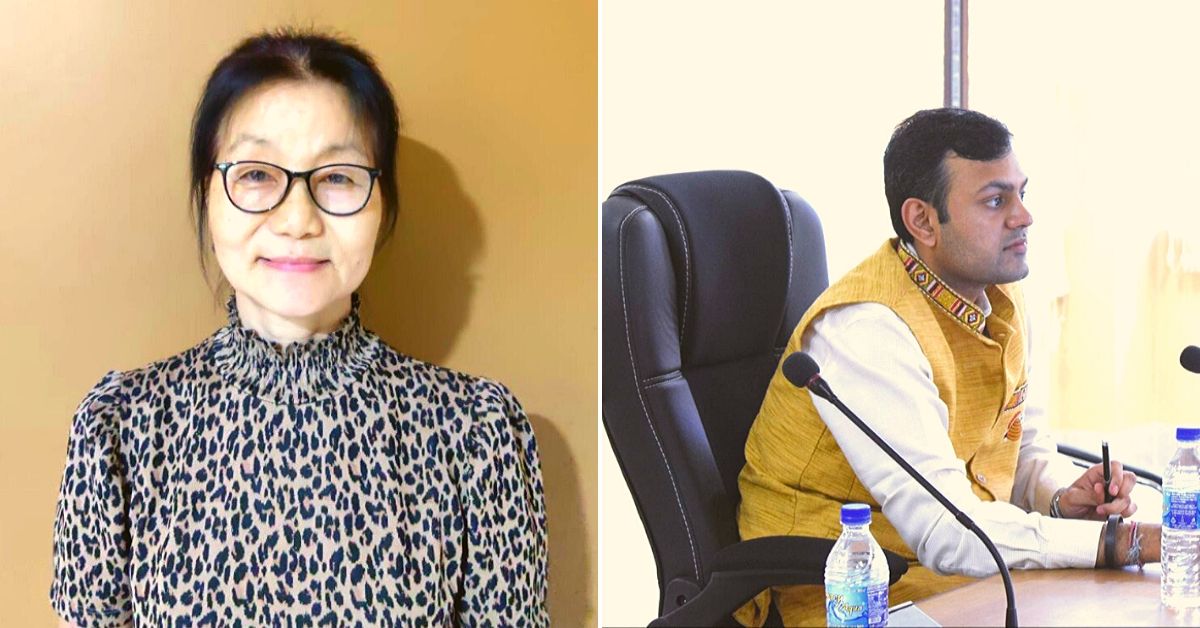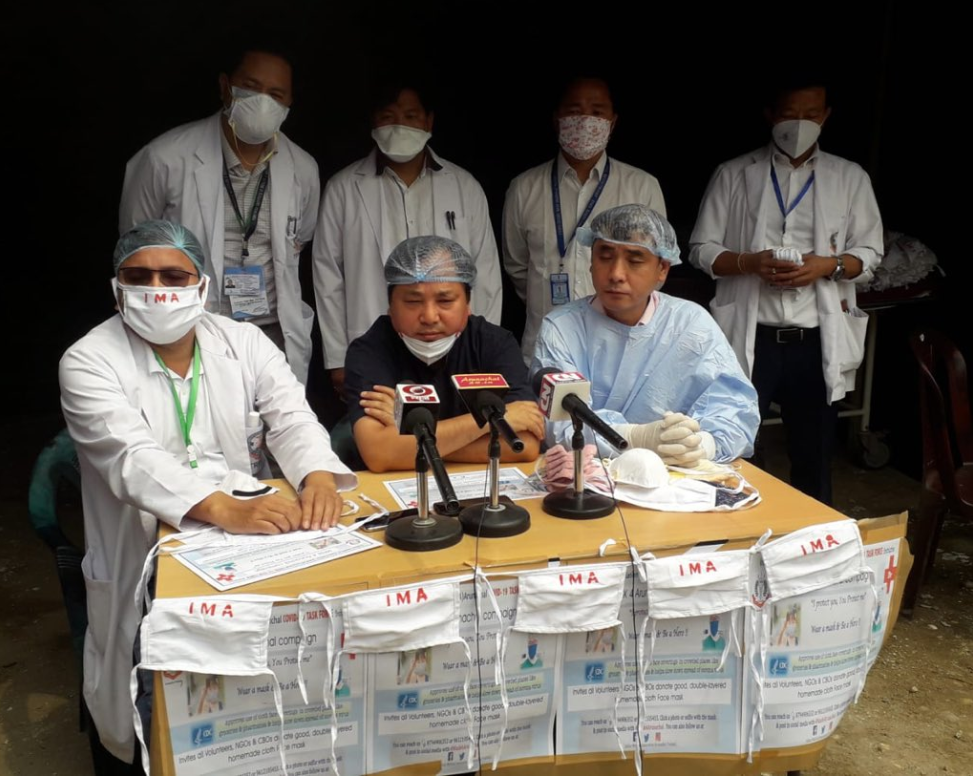Doctor, IAS Help Arunachal Stay Calm, As its First COVID-19 Victim Recovers
"Dr Sajinglu Chai Pul led from the front. She offered counselling to the patient, his family members, and closely engaged with the community at large,” says the Deputy Commissioner of Lohit district.

On 31 March 2020, the Lohit district administration in Arunachal Pradesh received information from various sources about a person with a history of travelling to Delhi whom they were trying to trace. Although the said person was already under home quarantine in Medo village since 20 March, he didn’t clearly inform the authorities about his recent travel history.
Armed with this information, a medical team led by the District Medical Officer Dr Sajinglu Chai Pul and District Surveillance Officer Dr S Towang, immediately made their way to Medo, where they took his swab sample and sent it for testing the same evening.
Taking no chances, the person and his entire family were taken to the nearest quarantine facility in Wakro village. The medical team took all necessary measures to ensure that no community transmission took place if he tested positive.
The results finally came in on 2 April, and the person had tested positive for COVID-19, following which he was immediately shifted to the isolation ward at the zonal General Hospital in Tezu, the district headquarters.
When news arrived of the subject testing positive for COVID-19, all hell broke loose. There was widespread panic on the ground. On social media, anti-social elements began targeting the person, his family and the religious community he belonged to. A photo of his family being taken into quarantine had been leaked online. There was public criticism of the district administration as well. But those on the frontlines weren’t rattled. They calmly went about their work—and saw the affected man to full recovery. And this is how they prepared themselves.
The Power of Foresight
“It’s all about timely mass communication and awareness. When news of the positive case had spread, we immediately reached out to influential community groups. We conducted micro-level meetings since large gatherings weren’t advisable and aggressively deployed IEC (information, education and communication) campaigns, besides employing our local language public announcers. This was also about instilling a sense of confidence among the people that we can handle this epidemic and there is no need to panic,” says Deputy Commissioner Prince Dhawan, speaking to The Better India.
It was a joint effort by the district administration, police and the medical team. What particularly helped was their level of preparation for such an eventuality.
Along with the medical superintendent of the General Hospital, Dr Chai Pul had identified the isolation facility and medical teams required to deal with positive cases well before the first such patient was announced. With the first positive case, they had closed down the OPD, but since the case wasn’t severe, they kept the flu corner and casualty unit open.

Steps were also taken for doctors and nurses on the frontlines to ensure they were mentally prepared in case of any eventuality well before the first positive case. Three 10-member teams, including doctors and nurses to oversee the patient, were set up. The first team would oversee the positive case for 10 days, followed by a 14-day quarantine period. After the first team finished its 10 day-stint, the second team would take over and so on.
These teams also included lab technicians—who had to collect swabs from the patient—and safai karamcharis—who had to enter the isolation ward to clean and disinfect it. The district had also set up a team of counselors to offer psychological help to those under the previous lockdown, and there were designated quarantine living quarters for doctors, nurses. They also had specified vehicles that would take them to the hospital and back to the quarantine facility.
“Since the patient was asymptomatic, we were confident of his eventual recovery. Moreover, there were guidelines set that in case the patient’s condition worsens significantly and turns severe, we would transport him to Dibrugarh Medical College,” says Dr Chai Pul, speaking to TBI. Given that the patient was asymptomatic, doctors treated him by giving vitamins but not antibiotics, reports Arunachal Times. “We had to focus on non-pharmaceutical intervention,” she told the local publication.
The medical workers who treated the first patient are still under quarantine.
Battling Fear & Anxiety: Preventive Measures
“We had already arranged for counsellors, and even started a district-level helpline that would help locals address their mental health concerns during a lockdown. Continuous engagement with all the stakeholders in the district meant that we included community organizations into the process of managing the epidemic. We reached out to the Cultural and Literary Society of Mishmis (CALSOM), All Mishmi Student Union (AMSU), All Mishmi Women Welfare Society (AMWWS) and other similar organisations. They were part of the process at every step. Their office bearers could see where things were going and they helped us spread our message to others,” says DC Dhawan.
He goes onto state that the district administration also intensified their engagement with local elected representatives. By garnering their cooperation, they were able to send across the right message to the general public and diffuse any unfounded fears.
“Yes, we were scared when he tested positive, but the entire medical team here was already well trained, oriented and underwent sensitisation workshops at Itanagar. When we came back, we sensitised almost everyone in the local medical fraternity all the way to ASHA workers, disseminated information through radio talks and set up a roster of doctor duties. While there was anxiety among doctors and nurses about quality and the lack of PPEs, but fortunately more kits had arrived by the night the patient was admitted. We were well prepared,” says Dr Chai Pul.
Initially people were scared to even collect samples from the patient. Dr S Towang, the first person on the spot stepped in, to ensure their samples were collected and even helped out the patient’s family. The district administration, working closely with the local police force, played an integral part in organising the logistics of identifying, tracing the patient’s contacts, quarantining them post contact tracing and ensuring their welfare.
The administration played a key role in calming the local community down. In Medo village, where the patient tested positive, a lot of work had to be done to ensure people weren’t gripped by fear. After the village was declared a containment zone, frontline health workers in Medo’s primary health clinic conducted house to house surveys with the help of ASHA workers. Overall, it was a coordinated team effort. Each department played their role.
In order to service immediate food requirements of migrant/daily wage workers of lohit district amidst lockdown, lohit Dist. Administration has distributed free rations to workers without ration cards in order to avoid any distress situation such as food crisis. pic.twitter.com/0LRck3s3PI
— Lohit DC (@DcLohit) March 30, 2020
“When the patient tested positive, we were compelled to organise further public meetings wearing protective gear and maintaining social distancing. The Deputy Commissioner, Superintendent of Police, District Surveillance Officer and I were compelled to address the public in micro-gatherings of course and repeatedly explain the situation to them. After our repeated assurances, things got better,” says Dr Chai Pul.
The district medical team has played an extremely crucial role in the entire episode because after all they had to handle the patient, claims DC Dhawan. “Dr Chai Pul led from the front by giving it her all. She offered counselling to the patient, his family members, and closely engaged with the community at large,” he adds.
Until the patient recovered on 17 April, the entire medical team assisted in counselling him, including the DMO. Although the patient has been discharged from the hospital, he is still being kept under a mandatory 14-day quarantine period as a matter of precaution.

“We have sufficient numbers of personal protective equipment (PPE) and are equipped to handle up to moderate cases of COVID-19. Nearly 90 per cent of the people have completed their mandatory 14-day quarantine period with active surveillance. Now, they are in the 14-day self-reporting period, although they are still under surveillance. For active surveillance, we roped in the services of ASHA workers and booth-level election workers since they are well conversant with the localities. There are no suspected cases as of now,” says DC Dhawan.
What the example of Lohit district illustrates is how the district administration, particularly the medical team led by Dr Chai Pul, did not panic or give in to the public’s fear. Instead, they went about their duties and treated the patient to a full recovery.
Also Read: COVID-19: How an Andhra-Based App Delivers Groceries in Remote Arunachal District
(Edited by Saiqua Sultan)
Like this story? Or have something to share? Write to us: [email protected], or connect with us on Facebook and Twitter.
If you found our stories insightful, informative, or even just enjoyable, we invite you to consider making a voluntary payment to support the work we do at The Better India. Your contribution helps us continue producing quality content that educates, inspires, and drives positive change.
Choose one of the payment options below for your contribution-
By paying for the stories you value, you directly contribute to sustaining our efforts focused on making a difference in the world. Together, let’s ensure that impactful stories continue to be told and shared, enriching lives and communities alike.
Thank you for your support. Here are some frequently asked questions you might find helpful to know why you are contributing?


This story made me
-
97
-
121
-
89
-
167











